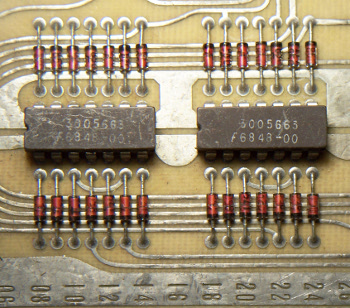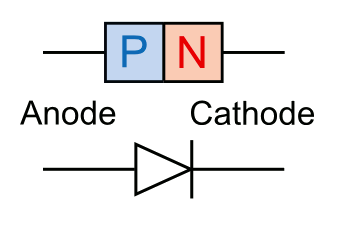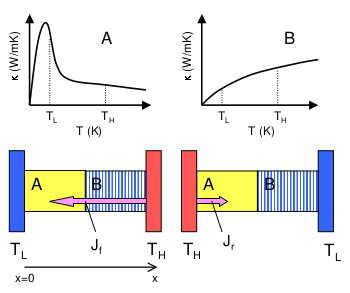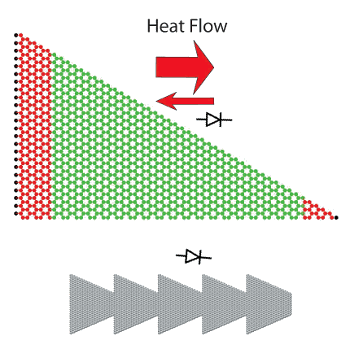Thermal Diodes
February 19, 2014
The simplest
semiconductor device is the
diode. Transistors are the crowning achievement of
solid state electronics, but diodes have been very useful devices. Used as
rectifiers, semiconductor diodes function as miniature replacements for
vacuum tubes in
power supplies. In the early days of
computing, they were ubiquitous in
circuitry known as
diode-transistor logic, DTL (see figure).

Portion of a circa 1967 circuit board from a Univac computer.
The many diodes are part of a diode-transistor logic (DTL) circuit.
(Photograph by the author.)
Semiconductor diodes allow
current flow in one direction, only. Such current
rectification is accomplished by a little
physics and a lot of
materials science. In the history of semiconductors, the availability of
crystalline materials with particular properties has always been the rate-limiting step in device development. A junction diode is shown schematically in the figure, below, and there's an online tutorial available on
YouTube.[1]

Semiconductor diode P-N junction and symbol.
(Illustration by the author, rendered using Inkscape.)
A junction diode is comprised of two contacting materials, an
N-type and a
P-type. These are usually the same crystal, such as
silicon, but with small impurities, called
dopants, to obtain these junction types. A dopant with excess
electrons, called a
donor, will make an N-type material, while a dopant deficient in electrons, called an
acceptor, will make a P-type material. For silicon,
arsenic is a typical donor, having five valence electrons to silicon's four, while
boron, with three valence electrons, is a typical acceptor.
Electrons are the
majority charge carriers in N-type material, while
holes (missing electrons) are the majority charge carriers in P-type material. Because of an
energy difference seen by electrons in these two materials, electrons will flow from the
cathode (N-type) to the
anode (P-type), but not in the reverse direction. Electrical current will flow in just one direction through diodes.
Diodes are so useful in electronics, it's not surprising that the diode concept is being extended to
heat; that is, diodes for which heat will flow in one direction, only.
Thermodynamics would still require heat to flow from a warmer body to a cooler one, but such a
thermal diode could impede heat flow in one direction and allow heat flow in the other.
The key to development of such a device is an understanding of how heat is transported in solids. As I wrote in a
previous article (Sound and Heat, August 23, 2011), heat in materials is conveyed by acoustic vibrations called phonons, and it's possible to change the behavior of phonons in various ways.
lattice vacancies will scatter phonons, but these will influence phonons only at high temperatures. Structures of larger dimension are effective at scattering phonons at lower temperatures. These are usually built as alternating layers of different acoustic impedance. Heat transmission is inhibited in such layered material, since there's reflection of phonons at the interfaces.
This particular concept has been proven in the layered compound, WSe2, which has alternate tungsten and selenium layers,[2] and layers of tungsten and alumina.[3] Nano-dot barriers in SiGe layered structures have been shown to produce a low thermal conductivity material at room temperature with as few as five barrier layers.[4]
Of course, these thermal barrier materials are not thermal diodes, since they work the same in both directions. The first practical thermal diode was demonstrated in 2009 by scientists at Waseda University (Tokyo, Japan).[5-6] The diode construction, as shown in the figure, resembles a junction diode. In this case, one junction material has a thermal conductivity that decreases with temperature, and the other has the opposite property.

Thermal conductivity effect thermal diode.
A junction between materials with opposite temperature coefficients of thermal conductivity produces the thermal diode effect.
(Fig. 1 of ref. 5, via arXiv.[5]
The rectifying coefficient of this thermal diode is just 1.43; that is, there's a 43% greater heat flow in one direction than the other, provided that the diode is in the proper temperature range.[5] The junction materials used were the perovskite cobalt oxides, LaCoO3 and La0.7Sr0.3CoO3.[5-6]
Engineers and physicists from Purdue University have recently proposed a thermal diode architecture based on phonon confinement in the lateral dimension of graphene nanoribbons. These ribbons, if formed into asymmetric structures, will allow thermal rectification.[7-8] These diodes have not yet been proven by experiment, but molecular dynamics simulation has shown thermal rectification in asymmetric graphene nanoribbons.[8]
Phonons will be laterally confined in graphene nanoribbons only when the cross section is much smaller than a phonon's mean free path, which is in the tens to hundreds of nanometer range, depending on the material.[8] If such ribbons are patterned into triangles, there's a greater heat flow in one direction than the other. These structures can be linked to provide better rectification (see figure).[8]

Purdue University thermal rectifier concept.
Small, triangular graphene nanoribbons will transfer more heat in one direction than the other, and the triangles can be linked to produce a greater effect.
(Reformatted Purdue University image.)
This useful phonon effect will also be present in other materials. Says Xiulin Ruan, an associate professor of mechanical engineering at Purdue and an author of the study,
"Asymmetric materials, such as asymmetric nanowires, thin films, and quantum dots of a single material can also be high-performance thermal rectifiers, as long as you have lateral confinement... This really broadens the potential of this rectification to a much wider spectrum of applications."[8]
One application could be a "thermal transistor" that used phonons instead of electrons for operation.[8]. Another might be building insulation. Says Ruan,
"For example, on a winter night you don't want a building to lose heat quickly to the outside, while during the day you want the building to be warmed up by the sun, so it would be good to have building materials that permit the flow of heat in one direction, but not the other."[8]
The research was funded by the U.S. Air Force Office of Scientific Research.[8]
References:
- The PN Junction - How Diodes Work (English version), YouTube video, Teaching Innovation Project 11-293 of Universidad de Granada (Spain), May 4, 2013.
- Catalin Chiritescu, David G. Cahill, Ngoc Nguyen, David Johnson, Arun Bodapati, Pawel Keblinski and Paul Zschack, "Ultralow Thermal Conductivity in Disordered, Layered WSe2 Crystals," Science, vol. 315, no. 5810 (January 19, 2007), pp. 351-353.
- R. M. Costescu, D. G. Cahill, F. H. Fabreguette, Z. A. Sechrist and S. M. George, "Ultra-Low Thermal Conductivity in W/Al2O3 Nanolaminates," Science, vol. 303, no. 5660 (February 13, 2004), pp. 989-990.
- G. Pernot, M. Stoffel, I. Savic, F. Pezzoli, P. Chen, G. Savelli, A. Jacquot, J. Schumann, U. Denker, I. Mönch, Ch. Deneke, O. G. Schmidt, J. M. Rampnoux, S. Wang, M. Plissonnier, A. Rastelli, S. Dilhaire and N. Mingo, "Precise control of thermal conductivity at the nanoscale through individual phonon-scattering barriers," Nature Materials, vol. 9, no. 6 (June, 2010), pp. 491-495.
- W. Kobayashi, Y. Teraoka and I. Terasaki, "An oxide thermal rectifier," Applied Physics Letters, vol. 95, no. 17 (October, 2009), Document No. 171905 (3 pages); available, also, on arXiv.
- Heat Diode Paves the Way For Thermal Computing, Technology Review, October 9, 2009.
- Yan Wang, Ajit Vallabhaneni, Jiuning Hu, Bo Qiu, Yong P. Chen and Xiulin Ruan, "Phonon Lateral Confinement Enables Thermal Rectification in Asymmetric Single-Material Nanostructures," Nano Letters, Article ASAP (January 6, 2014), DOI: 10.1021/nl403773f.
- Emil Venere, "Research could bring new devices that control heat flow," Purdue University Press Release, January 27, 2014.
Permanent Link to this article
Linked Keywords: Semiconductor device; junction diode; diode; transistor; solid state electronics; rectifier; vacuum tube; power supply; computing; electronic circuit; circuitry; diode-transistor logic; DTL; printed circuit board; Univac; electric current; rectifier; rectification; physics; materials science; crystal; crystalline material; YouTube; Inkscape; N-type semiconductor; P-type semiconductor; silicon; dopant; electron; donor; acceptor; arsenic; boron; majority charge carrier; hole; potential energy; energy difference; cathode; anode; heat; thermodynamics; thermal diode; material; acoustics; acoustic vibrations; phonon; vacancy defect; lattice vacancy; temperature; acoustic impedance; thermal conductivity; heat transmission; reflection; tungsten; W; selenium; Se; aluminium oxide; alumina; quantum dot; nano-dot; silicon-germanium; SiGe; scientist; Waseda University (Tokyo, Japan); temperature coefficient; thermal conductivity; arXiv; perovskite; cobalt; oxide; lanthanum; La; cobalt; Co; strontium; Sr; engineer; physicist; Purdue University; graphene nanoribbon; asymmetry; asymmetric; experiment; molecular dynamics; simulation; cross section; mean free path; nanometer; triangle; Xiulin Ruan; associate professor; mechanical engineering; building insulation; U.S. Air Force Office of Scientific Research.